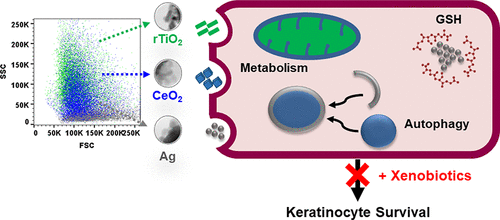当前位置:
X-MOL 学术
›
Chem. Res. Toxicol.
›
论文详情
Our official English website, www.x-mol.net, welcomes your feedback! (Note: you will need to create a separate account there.)
Survival Mechanisms and Xenobiotic Susceptibility of Keratinocytes Exposed to Metal-Derived Nanoparticles.
Chemical Research in Toxicology ( IF 4.1 ) Pub Date : 2020-01-30 , DOI: 10.1021/acs.chemrestox.9b00398 Veronica Montesinos-Cruz 1 , Jordan Rose , Aglaia Pappa 2 , Mihalis I Panayiotidis 3 , Andrea De Vizcaya-Ruiz 1 , Rodrigo Franco
Chemical Research in Toxicology ( IF 4.1 ) Pub Date : 2020-01-30 , DOI: 10.1021/acs.chemrestox.9b00398 Veronica Montesinos-Cruz 1 , Jordan Rose , Aglaia Pappa 2 , Mihalis I Panayiotidis 3 , Andrea De Vizcaya-Ruiz 1 , Rodrigo Franco
Affiliation

|
Metal-derived nanoparticles (Mt-NPs) are increasingly used in cosmetology due to their ultraviolet shielding (titanium dioxide [TiO2]), antioxidant (cerium dioxide [CeO2]), and biocidal (silver [Ag]) properties. In the absence of overt toxicity (i.e., cell death), Mt-NPs are considered safe for cosmetic applications. However, there is little understanding about the mechanisms involved in the survival of keratinocytes exposed to subtoxic levels of Mt-NPs. Human keratinocytes (HaCaT) were exposed subacutely to subtoxic concentrations (≤30 μg/mL, 48-72 h) of rutile (r) TiO2 (cylindrical), CeO2 (cubic) and Ag (spherical) with a core/hydrodynamic size of <50/<100 nm and >98% purity. Mt-NP uptake was indirectly quantified by changes in the light side scatter, where the kinetics (time/dose-response) suggested that the three types of Mt-NPs were similarly uptaken by keratinocytes. rTiO2 and CeO2, but not Ag-NPs, increased autophagy, whose inhibition prompted cell death. No increase in the steady-state levels of reactive oxygen species (ROS) was induced by exposure to any of the Mt-NPs tested. Interestingly, intracellular Ag-NP aggregates observed an increased far-red autofluorescence (≥740 nm em), which has been ascribed to their binding to thiol molecules such as glutathione (GSH). Accordingly, inhibition of GSH synthesis, but not the impairment of oxidized GSH recycling, sensitized keratinocytes to Ag-NPs suggesting that GSH homeostasis, and its direct scavenging of Ag-NPs, but not ROS, is essential for keratinocyte survival upon exposure to Ag-NP. rTiO2 and Ag, but not CeO2-NPs, compromised metabolic flux (glycolysis and respiration), but ATP levels were unaltered. Finally, we also observed that exposure to Mt-NPs sensitized keratinocytes to non-UV xenobiotic exposure (arsenite and paraquat). Our results demonstrate the differential contribution of autophagy and GSH homeostasis to the survival of human keratinocytes exposed to subtoxic concentrations of Mt-NPs and highlight the increased susceptibility of keratinocytes exposed to Mt-NPs to a second xenobiotic insult.
中文翻译:

角质形成细胞暴露于金属衍生的纳米粒子的生存机制和异质易感性。
金属衍生的纳米粒子(Mt-NPs)由于其紫外线屏蔽(二氧化钛[TiO2]),抗氧化剂(二氧化铈[CeO2])和杀菌(银[Ag])特性而越来越多地用于美容领域。在没有明显的毒性(即细胞死亡)的情况下,Mt-NP被认为可安全用于化妆品。但是,对暴露于亚毒性水平的Mt-NPs的角质形成细胞生存所涉及的机制了解甚少。人类角质形成细胞(HaCaT)急性暴露于亚毒性浓度(≤30μg/ mL,48-72 h)的金红石(r)TiO2(圆柱),CeO2(立方)和Ag(球形),其核心/流体动力学尺寸< 50 / <100 nm和> 98%纯度。Mt-NP摄取是通过光侧向散射的变化间接量化的,动力学(时间/剂量反应)表明三种类型的Mt-NP被角质形成细胞摄取。rTiO2和CeO2(而不是Ag-NP)增加自噬,其抑制作用导致细胞死亡。暴露于任何测试的Mt-NPs不会引起活性氧(ROS)稳态水平的增加。有趣的是,细胞内Ag-NP聚集体观察到远红外自发荧光增加(≥740 nm em),这归因于它们与巯基分子(如谷胱甘肽(GSH))的结合。因此,抑制GSH合成,而不是氧化GSH循环的损伤,使角质形成细胞对Ag-NP敏感,这表明GSH稳态及其直接清除Ag-NP而不是ROS对暴露于Ag-NP后的角质形成细胞生存至关重要。 NP。rTiO2和Ag,但不是CeO2-NP,代谢通量受损(糖酵解和呼吸),但ATP水平未改变。最后,我们还观察到,暴露于Mt-NPs可使角质形成细胞对非UV外源生物(砷和百草枯)敏感。我们的结果表明自噬和GSH稳态对暴露于亚毒性浓度的Mt-NPs的人类角化细胞存活的不同贡献,并强调了暴露于Mt-NPs的角质形成细胞对第二种异源生物的敏感性增加。
更新日期:2020-01-31
中文翻译:

角质形成细胞暴露于金属衍生的纳米粒子的生存机制和异质易感性。
金属衍生的纳米粒子(Mt-NPs)由于其紫外线屏蔽(二氧化钛[TiO2]),抗氧化剂(二氧化铈[CeO2])和杀菌(银[Ag])特性而越来越多地用于美容领域。在没有明显的毒性(即细胞死亡)的情况下,Mt-NP被认为可安全用于化妆品。但是,对暴露于亚毒性水平的Mt-NPs的角质形成细胞生存所涉及的机制了解甚少。人类角质形成细胞(HaCaT)急性暴露于亚毒性浓度(≤30μg/ mL,48-72 h)的金红石(r)TiO2(圆柱),CeO2(立方)和Ag(球形),其核心/流体动力学尺寸< 50 / <100 nm和> 98%纯度。Mt-NP摄取是通过光侧向散射的变化间接量化的,动力学(时间/剂量反应)表明三种类型的Mt-NP被角质形成细胞摄取。rTiO2和CeO2(而不是Ag-NP)增加自噬,其抑制作用导致细胞死亡。暴露于任何测试的Mt-NPs不会引起活性氧(ROS)稳态水平的增加。有趣的是,细胞内Ag-NP聚集体观察到远红外自发荧光增加(≥740 nm em),这归因于它们与巯基分子(如谷胱甘肽(GSH))的结合。因此,抑制GSH合成,而不是氧化GSH循环的损伤,使角质形成细胞对Ag-NP敏感,这表明GSH稳态及其直接清除Ag-NP而不是ROS对暴露于Ag-NP后的角质形成细胞生存至关重要。 NP。rTiO2和Ag,但不是CeO2-NP,代谢通量受损(糖酵解和呼吸),但ATP水平未改变。最后,我们还观察到,暴露于Mt-NPs可使角质形成细胞对非UV外源生物(砷和百草枯)敏感。我们的结果表明自噬和GSH稳态对暴露于亚毒性浓度的Mt-NPs的人类角化细胞存活的不同贡献,并强调了暴露于Mt-NPs的角质形成细胞对第二种异源生物的敏感性增加。


























 京公网安备 11010802027423号
京公网安备 11010802027423号